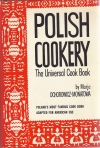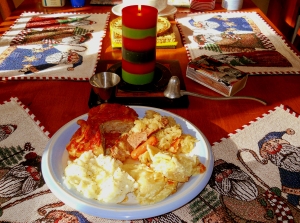 Let me first confess that this year’s stuffing was not my best rendition. I was so thrilled that I had homemade turkey stock to add to the mixture, frozen a few months ago for just this occasion, that I overdid the moisture part. Or maybe the moisture just didn’t absorb as well as usual into the bread/croutons because, for the first time ever, I didn’t dig into the bowl with my hands and mush all the ingredients together, as I’d been taught to do by my mother. Apparently I was led astray by those gorgeous photographs of stuffing spilling out of the turkey’s cavity, with obvious chunks of bread, aromatics and sausage on display.
Let me first confess that this year’s stuffing was not my best rendition. I was so thrilled that I had homemade turkey stock to add to the mixture, frozen a few months ago for just this occasion, that I overdid the moisture part. Or maybe the moisture just didn’t absorb as well as usual into the bread/croutons because, for the first time ever, I didn’t dig into the bowl with my hands and mush all the ingredients together, as I’d been taught to do by my mother. Apparently I was led astray by those gorgeous photographs of stuffing spilling out of the turkey’s cavity, with obvious chunks of bread, aromatics and sausage on display.
Well, our family likes most of those ingredients well-combined. Besides, not “mushing” can also result in a too-dry stuffing!
The recipe for stuffing in this blogpost is adjusted so that readers can make their own judgments on how much liquid to add to their stuffing, based on what I used and what I’d suggest starting out with. Our stuffing wasn’t waterlogged but could’ve done well with perhaps half-a-cup less of stock. It tasted great, however, and it was even better a couple days later as part of the topping (along with some of the potato casserole) on a Turkey Shepherd’s Pie.
As mentioned in yesterday’s entry, I opted for stuffing in the turkey rather than just filling its cavity with lemon and herbs and making it totally a side dish, baked separately. There’s never too much stuffing.
 Only one family memory regarding stuffing and then on to the recipe. My father often got involved in the cooking on Thanksgiving, at least in Big Bird part, and he would sometimes mix together what he called “a Polish stuffing,” which translated to how his mother made it. Nana Zembo (who arrived in this country from Poland early in the 20th century) made a version that included raisins. I was never certain this was a true Polish food tradition until I perused my copy of Polish Cookery: The Universal Cook Book by Marja Ochorowicz-Monatowa (Crown Publishers; my copy is its 13th printing, 1975). It contains two raisin stuffing recipes, one in the “Poultry and Poultry Stuffings” section and the other under “Stuffings for Roast Pig.” I didn’t own this book, however, when I tried making a rendition of Nana’s dish. All I did was add raisins to my usual recipe (and maybe some diced apples or applesauce). Tasted glorious to me, but I found I was also the only one eating it. Our traditional TurkeyDay dressing disappeared into well-filled bellies but I guess “honoring our Polish heritage” only goes so far.
Only one family memory regarding stuffing and then on to the recipe. My father often got involved in the cooking on Thanksgiving, at least in Big Bird part, and he would sometimes mix together what he called “a Polish stuffing,” which translated to how his mother made it. Nana Zembo (who arrived in this country from Poland early in the 20th century) made a version that included raisins. I was never certain this was a true Polish food tradition until I perused my copy of Polish Cookery: The Universal Cook Book by Marja Ochorowicz-Monatowa (Crown Publishers; my copy is its 13th printing, 1975). It contains two raisin stuffing recipes, one in the “Poultry and Poultry Stuffings” section and the other under “Stuffings for Roast Pig.” I didn’t own this book, however, when I tried making a rendition of Nana’s dish. All I did was add raisins to my usual recipe (and maybe some diced apples or applesauce). Tasted glorious to me, but I found I was also the only one eating it. Our traditional TurkeyDay dressing disappeared into well-filled bellies but I guess “honoring our Polish heritage” only goes so far.
With that said, here’s the Day-Zembo family’s “usual” turkey stuffing. I create the same recipe for chicken, only with chicken stock (in fact, in past years it’s often been chicken stock that went into the turkey stuffing).
DAY-ZEMBO FAMILY TURKEY STUFFING
Yield: Enough to fill cavity of a 17-18 lb. turkey, plus a large ovenproof bowl/pan
Ingredients
- 5 to 6 generous cups homemade (or supermarket purchased), herbed croutons – more if needed
- Up to 1 quart turkey broth (you’ll start with less & eyeball it for moisture)
- 1 tablespoon oil (more if needed, as sometimes is the case with turkey sausage)
- 10 to 12 ounces turkey (or pork) sausage
- 1 to 2 tablespoons butter
- 3 medium to large onions, peeled and chopped
- 1 medium carrot, peeled and diced small (Mom never added carrots; it’s my way of sneaking some extra nutrition into the mix.)
- 3 large celery stalks, peeled and chopped
- 3 garlic cloves, peeled and finely chopped
- salt and pepper, to taste (minimum, however, of a teaspoon of salt and ½ teaspoon of pepper)
- 1 teaspoon dried thyme
- 1 tablespoon dried sage
- 1 tablespoon dried parsley
- a couple tablespoons Bell’s Seasoning, if desired
- 2 large eggs, lightly beaten (optional but advisable; I didn’t include them this time— had I done so, perhaps they would have offset the extra moisture since eggs work as binders)
- additional butter to dot dish of extra stuffing
Process
- Into a very large bowl, pour the croutons.
- Heat oil in a large skillet and add sausage. Sauté until browned, using spatula as it cooks, to break into small bits. (I had to use turkey sausage – daughter doesn’t eat pork or red meat – and couldn’t find a package of it with “breakfast sausage” seasonings in it, so wound up with a 9.6 oz. package of Jimmy Dean Hearty Sausage Crumbles.) If sausage is the pre-cooked kind, still sauté to warm it and to add flavor to the pan.
- Remove sausage to a paper-towel-covered plate to drain.
- Add butter to skillet and, when melted, further add onions, carrots and celery, cooking for about three minutes. Sprinkle with salt and pepper.
- Add garlic to pan and sauté for an additional minute, monitoring mixture to be sure garlic doesn’t burn.
- Return sausage to pan and add about a cup of the stock. Use spatula to scrape any pan brownings up, further flavoring the broth mix. (This is called deglazing.)
- After a few minutes, turn heat off and add contents of pan to the bowl of croutons, mixing together well.
- Add one cup of warm stock (I microwave it) to mixture, plus the thyme, sage, parsley and Bell’s Seasoning (if using). Also add any additional salt and/or pepper, as desired.
- Ensuring first that the mixture is cool enough not to “cook” the eggs upon addition, add eggs to the mix and stir until combined.
- Then DIG IN with those hands, mushing the mix together. You aren’t going to make it into one gooey mess, breaking down veggies into nothingness, but croutons should be well-dampened with some of them broken down entirely. (If it’s a bit dry, add more stock— a little at a time to avoid overdoing it. Too wet? No harm in adding more croutons. Judgment call.)
- If roasting stuffing inside the bird, as well as in a separate dish, make sure turkey’s cavity is salted and then fill about ⅔ to ½ full (stuffing expands). I don’t bother to try to sew up the cavity; I simply pull drumsticks together and tie with kitchen twine. (See yesterday’s post for suggestions about roasting the bird.)
- Fill an appropriate-sized, ovenproof dish or pan with remaining stuffing. Dot with butter.
- Extra stuffing can be baked along with the turkey (but only for about 30 to 45 minutes of the turkey’s time, so schedule accordingly), or separately. Since we have only one oven in our kitchen and the bird takes up most of that space, I usually microwave stuffing until heated through and then place it in the oven after turkey has been removed and is resting on the counter. Bake it until browned on top and thoroughly heated through.
There you have it – my guidelines for great stuffing. It takes practice in judging exactly how much stock you’ll want in your own version. And still, after years of T-Days (or whenever you’re indulging in turkey), you might not come off with exactly the texture you were aiming for. Hopefully, however, it’ll still be full of flavor, as ours was – and it’ll work well in those recipes for leftovers!







